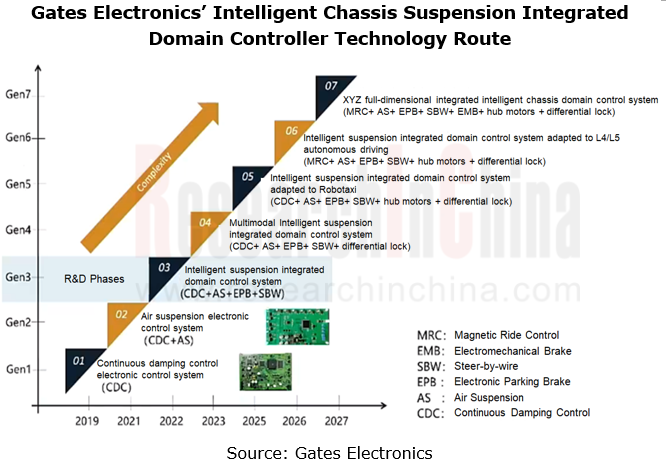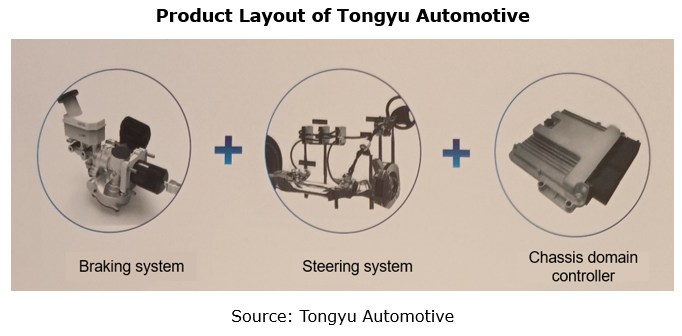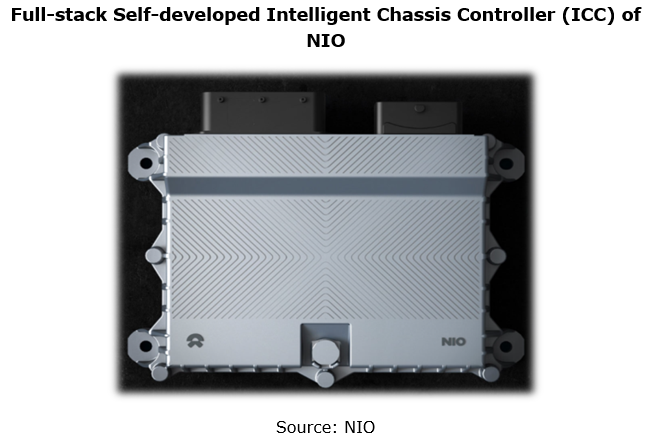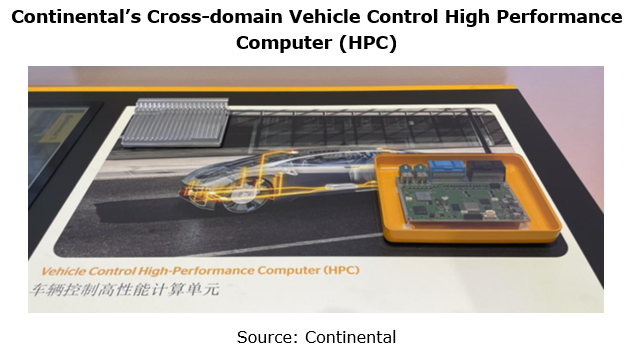Passenger Car Intelligent Chassis and Chassis Domain Controller Research Report, 2023
Passenger Car Intelligent Chassis and Chassis Domain Controller Research Report, 2023, released by ResearchInChina combs through three integration trends of brake-by-wire, steer-by-wire, and active suspension, and researches chassis control strategies, chassis domain controller products & planning of suppliers and OEMs.
As one of core technologies of vehicle intelligence, intelligent chassis can not only satisfy the requirements of high-level autonomous driving, but also bring safer and more comfortable driving experience to occupants and provide hardware support for vivid imagination of future intelligent cockpit. At this stage, intelligent chassis is composed of sub-components such as brake-by-wire, steer-by-wire and active suspension, and controls the chassis through digital signals to realize active adjustment at six degrees of freedom in lateral, longitudinal, and vertical directions, and provide bearings for vehicle autonomous driving system, cockpit system, and power system.

According to this report, intelligent chassis shows three major trends.
Trend 1: Chassis single-system integration continues to increase
Chassis single-system integration is mainly X-by-wire system integration, of which brake-by-wire system integration is the most typical.
 For steering system, the mainstream core actuator is still EPS (electric power steering), while steer-by-wire systems are less used. In the future, the key development trend of steer-by-wire system is integration of steer-by-wire structure and mechanical redundant structure.
For steering system, the mainstream core actuator is still EPS (electric power steering), while steer-by-wire systems are less used. In the future, the key development trend of steer-by-wire system is integration of steer-by-wire structure and mechanical redundant structure.
 Mainly based on air suspension, active suspension further adds sensors and electronic control systems for active adjustment of its height, stiffness and damping according to actual road conditions, so as to enables fine system control in driving/parking state and improve driving comfort.
Mainly based on air suspension, active suspension further adds sensors and electronic control systems for active adjustment of its height, stiffness and damping according to actual road conditions, so as to enables fine system control in driving/parking state and improve driving comfort.
 Representative route of brake-by-wire integration is EHB integrated with ABS/ESP, often known as One Box solution that features high integration and low cost and can meet autonomous driving requirements in combination with RBU (redundant brake unit), having been the most marketable X-by-wire product at this stage.
Representative route of brake-by-wire integration is EHB integrated with ABS/ESP, often known as One Box solution that features high integration and low cost and can meet autonomous driving requirements in combination with RBU (redundant brake unit), having been the most marketable X-by-wire product at this stage.
In terms of brake-by-wire integration, leading companies such as Bethel Automotive, Tongyu Automotive and TruGo Tech have already released relevant products.
 Bethel Automotive's wire-controlled brake system (WCBS), a One Box solution, integrates vacuum booster, electronic vacuum pump, master cylinder, ESC and EPB, and features high integration, light weight, quick braking response and low overall costs. WCBS (OneBox) came into mass production in June 2021, and was mass-produced for more than 20 models in 2022.
Bethel Automotive's wire-controlled brake system (WCBS), a One Box solution, integrates vacuum booster, electronic vacuum pump, master cylinder, ESC and EPB, and features high integration, light weight, quick braking response and low overall costs. WCBS (OneBox) came into mass production in June 2021, and was mass-produced for more than 20 models in 2022.
 Tongyu Automotive's Electronic Hydraulic Braking System with Integrated Electrical Parking Brake (EHB-EPBi) integrates the EPB control module into the EHB controller to reduce components and lower costs. As of October 2023, Tongyu Automotive has shipped more than 100,000 units of EHB-EPBi products. In addition, its integrated brake-by-wire (iEHB) product integrates five functional modules, namely, EHB, ESC, redundant EPB, intelligent tire monitoring and chassis domain control, which enables such functions as basic braking, brake-by-wire, park-by-wire, and stability control. Tongyu Automotive iEHB has been designated exclusively by OEMs and will be production-ready in late 2023.
Tongyu Automotive's Electronic Hydraulic Braking System with Integrated Electrical Parking Brake (EHB-EPBi) integrates the EPB control module into the EHB controller to reduce components and lower costs. As of October 2023, Tongyu Automotive has shipped more than 100,000 units of EHB-EPBi products. In addition, its integrated brake-by-wire (iEHB) product integrates five functional modules, namely, EHB, ESC, redundant EPB, intelligent tire monitoring and chassis domain control, which enables such functions as basic braking, brake-by-wire, park-by-wire, and stability control. Tongyu Automotive iEHB has been designated exclusively by OEMs and will be production-ready in late 2023.
 TruGo Tech's Electric Hydraulic Booster Integrated (EHBI), a One Box solution, integrates functions of ABS, ESC, E-booster, and EPB, and supports multi-sensor fusion, providing vehicles with good pedal feeling and emergency braking capability. EHBI (Onebox), officially launched in October 2022, combines over 30 intelligent functions such as booster control, cooperative brake energy recovery, wheel anti-lock braking control and body stability control.
TruGo Tech's Electric Hydraulic Booster Integrated (EHBI), a One Box solution, integrates functions of ABS, ESC, E-booster, and EPB, and supports multi-sensor fusion, providing vehicles with good pedal feeling and emergency braking capability. EHBI (Onebox), officially launched in October 2022, combines over 30 intelligent functions such as booster control, cooperative brake energy recovery, wheel anti-lock braking control and body stability control.
Trend 2: Chassis intra-domain integration enables cooperative XYZ control
Under the cooperative control by the chassis domain controller, fusion control of brake, steer, suspension and other X-by-wire systems allows for quicker dynamic response, shorter pressure build-up time, fine-grained precision brake-by-wire, steer-by-wire, and precision adjustment of electronic suspension parameters (flexibly adjusting damping, stiffness, height, and vibration control), and it can constantly and actively learn road conditions and environmental patterns to continuously improve chassis comfort performance.

For example, according to Gates Electronics' chassis integrated domain controller technology route, the Gen3 realizes integration of suspension (CDC), air suspension (AS), steer-by-wire (SBW) and EPB (electronic parking brake); the Gen5 adds hub motors; the Gen7 adds EMB (brake-by-wire).

As a representative supplier in the field of intra-domain integration, Tongyu Automotive makes product layout covering three major areas: intelligent braking system, steer-by-wire system and chassis domain controller. Tongyu Automotive is headquartered in Shanghai, and has two production bases in Jiading District of Shanghai and Yichun City of Jiangxi, with annual capacity of 1.5 million sets. As of October 2023, Tongyu Automotive has shipped nearly 400,000 sets of EHB systems, supporting over 100 vehicle models of over 80 well-known customers. After realizing mass adoption of X-by-wire systems in vehicles, Tongyu Automotive has started further developing EMB, steer-by-wire and chassis domain controller, heading in the direction of chassis intra-domain integration.

Trend 3: Cross-domain integration of chassis domain with other domains brings bigger imaginable space to SDV
Chassis intelligence includes not only intra-domain integration, but also cross-domain integration (with intelligent driving domain, body domain, power domain, etc.).
For example, China’s first full-stack self-developed intelligent chassis controller (ICC) NIO introduced in June 2022 centralizes core components of conventional chassis, including more than 100 component controllers such as suspension, damper, and EBP, into one domain controller at perception and decision levels, which is intelligently called and controlled by software algorithms. ICC is adaptable to autonomous driving, and makes a quick response to the predictions and decisions made by intelligent driving systems, improving vehicle comfort. For instance, in a NAD scenario, the intelligent driving domain fusion control system can simultaneously control the vehicle's 4WD distribution, brake-by-wire, variable suspension and other functions, effectively improving the vehicle's dynamic performance. NIO ICC has already been mass-produced for NT2.0 models, such as ET7, ET5, and ES7.

Li L9 is equipped with Li Auto's self-developed central domain controller. All the hardware, systems and software of this controller are completely self-developed by Li Auto. The controller integrates functions of range-extended electric system, air-conditioning system, chassis system and seat control system. Li Auto’s LEEA2.0 is three-domain architecture (central control domain + autonomous driving domain + intelligent cockpit domain), of which the central control domain contains power, body and partial chassis functions.
At the Auto Shanghai 2023, Continental first introduced its cross-domain vehicle control High Performance Computer (HPC), which is the first step in cross-domain integration of vehicle dynamic control functions. In addition to the original body control and gateway functions, this solution also integrates chassis control applications, and cross-domain vehicle control functions such as damping control, adaptive air suspension and chassis tuning. Continental's central dynamic control software acts as the command center that coordinates all vehicle motion actuators for longitudinal, lateral and vertical control. It is modular and scalable, serving as a unified interface that decouples driving functions from specific actuators and vehicle configurations.

In the future chassis cross-domain integration era, ECU and other control hardware as well as software algorithms all will be integrated into the chassis domain controller or the central computing unit, under which OEMs will tend to master their own control module technology. NIO, Li Auto and other OEMs with strong R&D strength have already held by way of self-development, and voices of conventional chassis suppliers are being weakened. In short, the chassis industry will see a big reshuffle in the intelligent transformation.
Autonomous Driving Domain Controller and Central Computing Unit (CCU) Industry Report, 2025
Research on Autonomous Driving Domain Controllers: Monthly Penetration Rate Exceeded 30% for the First Time, and 700T+ Ultrahigh-compute Domain Controller Products Are Rapidly Installed in Vehicles
L...
China Automotive Lighting and Ambient Lighting System Research Report, 2025
Automotive Lighting System Research: In 2025H1, Autonomous Driving System (ADS) Marker Lamps Saw an 11-Fold Year-on-Year Growth and the Installation Rate of Automotive LED Lighting Approached 90...
Ecological Domain and Automotive Hardware Expansion Research Report, 2025
ResearchInChina has released the Ecological Domain and Automotive Hardware Expansion Research Report, 2025, which delves into the application of various automotive extended hardware, supplier ecologic...
Automotive Seating Innovation Technology Trend Research Report, 2025
Automotive Seating Research: With Popularization of Comfort Functions, How to Properly "Stack Functions" for Seating?
This report studies the status quo of seating technologies and functions in aspe...
Research Report on Chinese Suppliers’ Overseas Layout of Intelligent Driving, 2025
Research on Overseas Layout of Intelligent Driving: There Are Multiple Challenges in Overseas Layout, and Light-Asset Cooperation with Foreign Suppliers Emerges as the Optimal Solution at Present
20...
High-Voltage Power Supply in New Energy Vehicle (BMS, BDU, Relay, Integrated Battery Box) Research Report, 2025
The high-voltage power supply system is a core component of new energy vehicles. The battery pack serves as the central energy source, with the capacity of power battery affecting the vehicle's range,...
Automotive Radio Frequency System-on-Chip (RF SoC) and Module Research Report, 2025
Automotive RF SoC Research: The Pace of Introducing "Nerve Endings" such as UWB, NTN Satellite Communication, NearLink, and WIFI into Intelligent Vehicles Quickens
RF SoC (Radio Frequency Syst...
Automotive Power Management ICs and Signal Chain Chips Industry Research Report, 2025
Analog chips are used to process continuous analog signals from the natural world, such as light, sound, electricity/magnetism, position/speed/acceleration, and temperature. They are mainly composed o...
Global and China Electronic Rearview Mirror Industry Report, 2025
Based on the installation location, electronic rearview mirrors can be divided into electronic interior rearview mirrors (i.e., streaming media rearview mirrors) and electronic exterior rearview mirro...
Intelligent Cockpit Tier 1 Supplier Research Report, 2025 (Chinese Companies)
Intelligent Cockpit Tier1 Suppliers Research: Emerging AI Cockpit Products Fuel Layout of Full-Scenario Cockpit Ecosystem
This report mainly analyzes the current layout, innovative products, and deve...
Next-generation Central and Zonal Communication Network Topology and Chip Industry Research Report, 2025
The automotive E/E architecture is evolving towards a "central computing + zonal control" architecture, where the central computing platform is responsible for high-computing-power tasks, and zonal co...
Vehicle-road-cloud Integration and C-V2X Industry Research Report, 2025
Vehicle-side C-V2X Application Scenarios: Transition from R16 to R17, Providing a Communication Base for High-level Autonomous Driving, with the C-V2X On-board Explosion Period Approaching
In 2024, t...
Intelligent Cockpit Patent Analysis Report, 2025
Patent Trend: Three Major Directions of Intelligent Cockpits in 2025
This report explores the development trends of cutting-edge intelligent cockpits from the perspective of patents. The research sco...
Smart Car Information Security (Cybersecurity and Data Security) Research Report, 2025
Research on Automotive Information Security: AI Fusion Intelligent Protection and Ecological Collaboration Ensure Cybersecurity and Data Security
At present, what are the security risks faced by inte...
New Energy Vehicle 800-1000V High-Voltage Architecture and Supply Chain Research Report, 2025
Research on 800-1000V Architecture: to be installed in over 7 million vehicles in 2030, marking the arrival of the era of full-domain high voltage and megawatt supercharging.
In 2025, the 800-1000V h...
Foreign Tier 1 ADAS Suppliers Industry Research Report 2025
Research on Overseas Tier 1 ADAS Suppliers: Three Paths for Foreign Enterprises to Transfer to NOA
Foreign Tier 1 ADAS suppliers are obviously lagging behind in the field of NOA.
In 2024, Aptiv (2.6...
VLA Large Model Applications in Automotive and Robotics Research Report, 2025
ResearchInChina releases "VLA Large Model Applications in Automotive and Robotics Research Report, 2025": The report summarizes and analyzes the technical origin, development stages, application cases...
OEMs’ Next-generation In-vehicle Infotainment (IVI) System Trends Report, 2025
ResearchInChina releases the "OEMs’ Next-generation In-vehicle Infotainment (IVI) System Trends Report, 2025", which sorts out iterative development context of mainstream automakers in terms of infota...